Machine Learning-Based Method for Predicting Compressive Strength of Concrete
Abstract
1. Introduction
2. Current Status of Research
2.1. Prediction of Concrete Compressive Strength Based on Bibliometric Analysis
2.1.1. Research Methodology and Data Sources
- Research methodology
2.1.2. Overview of Research into the Prediction of Compressive Strength of Concrete
- Time distribution characteristics
- Analysis of the authors of the literature
- Analysis by research institutions
- Keyword co-occurrence network analysis
- Keyword clustering mapping analysis
2.2. Status of Research on Prediction Methods
2.2.1. Traditional Methods
2.2.2. Machine-Learning Methods
3. Compressive Strength Prediction Model for Concrete Based on GBRT Algorithm
3.1. Introduction to the GBRT Algorithm
- GB
- RT
3.1.1. GBRT Algorithm Steps
- Initialization of the weak learner function.
- 2.
- For the m-th iteration (m є [1,M]):
- 3.
- After M iterations, the strong learner is finally obtained.
3.1.2. Implementation Process of GBRT
- Collection and processing of experimental data, including data normalisation, setting up input/output variables and training test dataset partitioning.
- The GBRT algorithm combines data from the training set to obtain a preliminary model, and data from the validation set are used to validate the preliminary model and adjust the hyperparameters to improve the algorithm’s learning performance and obtain the final predictive model.
- Test the performance of the trained prediction model with the test dataset.
- Apply the predictive model to a real problem.
3.1.3. Advantages and Disadvantages of the GBRT Algorithm
- Ability to handle mixed data types, including continuous and discrete values, flexibly;
- High predictive power;
- Good robustness benefits from a strong loss function, including least squares, least absolute deviation function, Huber and quantile in the case of outliers in the output space.
- 4.
- Poor scalability. Parallel training data is challenging due to dependencies between weak learners.
3.2. Datasets
3.3. Model Building
- Training set
- Validation set
- Test set
3.4. Results and Analysis
3.4.1. Comparison with Individual Machine-Learning Algorithms
3.4.2. Comparison with Other Ensemble Machine-Learning Algorithms
3.4.3. K-Fold Cross Validation Analysis
3.4.4. Analysis of the Importance of the Characteristics of the Input Variables
4. Conclusions
- At the macro level. Since 2015, the field has flourished with an increasingly mature theoretical system, driven by pioneers represented by Ali Nazari, a professor at Islamic Azad University, and has given rise to numerous hot research directions related to compressive strength.
- At the microscopic level. Concrete compressive strength prediction methods are mainly divided into traditional approaches and machine learning. Traditional methods include using the FCT prediction method, summarising empirical mathematical formulas, and using equivalent age theory, etc. Machine-learning methods can be divided into individual learning algorithms, such as ANN and SVM, and ensemble learning algorithms, such as BP and RF.
- The problems of the small amount of data and few studies of ensemble learning algorithms exist in the current research of using machine-learning algorithms to predict the compressive strength of concrete.
- The R2 of 0.92, MSE of 22.09 MPa and RMSE of 4.7 MPa for the GBRT model prove that the model has high prediction accuracy in predicting the compressive strength of concrete.
- Using the same database, the GBRT model was compared with prediction models constructed using classical individual learning algorithms such as ANN and SVM from previous work species. The GBRT model performed significantly better than these models. Moreover, the GBRT model has an advantage even when compared with other ensemble learning algorithms such as RF and AdaBoost.
- The R2 and RMSE values were calculated for each fold through a five-fold cross-validation analysis, and the model performance was found to be accurate.
- The importance coefficients of the eight input parameters were calculated by analysing the feature importance, and the effects of age and cement on concrete strength were found to be dominant.
Author Contributions
Funding
Data Availability Statement
Conflicts of Interest
References
- Gong, Z.; Pu, X.; Wu, H. Concrete compressive strength test based on vector machine optimized by particle swarm optimization algorithm. Concrete 2013, 12, 11–13. [Google Scholar]
- Feng, D.; Ren, X.; Li, J. Stochastic damage hysteretic model for concrete based on micromechanical approach. Int. J. Non-Linear Mech. 2016, 83, 15–25. [Google Scholar] [CrossRef]
- Feng, D.; Li, J. Stochastic nonlinear behavior of reinforced concrete frames. II: Numerical simulation. J. Struct. Eng. 2016, 142, 04015163. [Google Scholar] [CrossRef]
- Chen, Z.; Feng, Y.; Zhang, X.; Guo, X.; Shao, L.; Cao, Y.; Li, S.; Gao, L. Similarity criterion for the nonlinear thermal analysis of the soil freezing process: Considering the dual effect of nonlinear thermal parameters and boundary conditions. Acta Geotech. 2022, 17, 5709–5719. [Google Scholar] [CrossRef]
- Bischoff, P.; Perry, S. Compressive behaviour of concrete at high strain rates. Mater. Struct. 1991, 24, 425–450. [Google Scholar] [CrossRef]
- Lessard, M.; Challal, O.; Aticin, P. Testing high-strength concrete compressive strength. Mater. J. 1993, 90, 303–307. [Google Scholar]
- Shi, H.; Xu, B.; Zhou, X. Influence of mineral admixtures on compressive strength, gas permeability and carbonation of high performance concrete. Constr. Build. Mater. 2009, 23, 1980–1985. [Google Scholar] [CrossRef]
- Bhanja, S.; Sengupta, B. Investigations on the compressive strength of silica fume concrete using statistical methods. Cem. Concr. Res. 2002, 32, 1391–1394. [Google Scholar] [CrossRef]
- Bharatkumar, B.; Narayanan, R.; Raghuprasad, B.; Ramachandramurthy, D. Mix proportioning of high performance concrete. Cem. Concr. Compos. 2001, 23, 71–80. [Google Scholar] [CrossRef]
- Zain, M.F.M.; Abd, S.M. Multiple regression model for compressive strength prediction of high performance concrete. J. Appl. Sci. 2009, 9, 155–160. [Google Scholar] [CrossRef]
- Zhu, X. Strength prediction of high strength concrete using two nonlinear methods. Concrete 2011, 12, 28–30. [Google Scholar]
- Chen, Z.; Guo, X.; Shao, L.; Li, S.; Tian, X. Design of a three-dimensional earth pressure device and its application in a tailings dam construction simulation experiment. Acta Geotech. 2021, 16, 2203–2216. [Google Scholar] [CrossRef]
- Zhou, Z. Ensemble Methods: Foundations and Algorithms; CRC press: London, UK, 2012. [Google Scholar]
- Ababneh, A.; Alhassan, M.; Abu-Haifa, M. Predicting the contribution of recycled aggregate concrete to the shear capacity of beams without transverse reinforcement using artificial neural networks. Case. Stud. Constr. Mat. 2020, 13, e00414. [Google Scholar] [CrossRef]
- Alshboul, O.; Almasabha, G.; Shehadeh, A.; Mamlook, R.E.A.; Almuflih, A.S.; Almakayeel, N. Machine learning-based model for predicting the shear strength of slender reinforced concrete beams without stirrups. Buildings 2022, 12, 1166. [Google Scholar] [CrossRef]
- Moein, M.M.; Saradar, A.; Rahmati, K.; Mousavinejad, S.H.G.; Bristow, J.; Aramali, V.; Karakouzian, M. Predictive models for concrete properties using machine learning and deep learning approaches: A review. J. Build. Eng. 2022, 63, 105444. [Google Scholar] [CrossRef]
- Almasabha, G.; Alshboul, O.; Shehadeh, A.; Almuflih, A.S. Machine Learning Algorithm for Shear Strength Prediction of Short Links for Steel Buildings. Buildings 2022, 12, 775. [Google Scholar] [CrossRef]
- Mukhtar, F.; Deifalla, A. Shear strength of FRP reinforced deep concrete beams without stirrups: Test database and a critical shear crack-based model. Compos. Struct. 2022, 307, 116636. [Google Scholar] [CrossRef]
- Deng, F.; He, Y.; Zhou, S.; Yu, Y.; Cheng, H.; Wu, X. Compressive strength prediction of recycled concrete based on deep learning. Constr. Build. Mater. 2018, 175, 562–569. [Google Scholar] [CrossRef]
- Ozturan, M.; Kutlu, B.; Ozturan, T. Comparison of concrete strength prediction techniques with artificial neural network approach. Build. Res. J. 2008, 56, 23–36. [Google Scholar]
- Tayfur, G.; Erdem, T.K.; Kırca, Ö. Strength prediction of high-strength concrete by fuzzy logic and artificial neural networks. J. Mater. Civ. Eng. 2014, 26, 04014079. [Google Scholar] [CrossRef]
- Younis, K.H.; Pilakoutas, K. Strength prediction model and methods for improving recycled aggregate concrete. Constr. Build. Mater. 2013, 49, 688–701. [Google Scholar] [CrossRef]
- Amini, K.; Jalalpour, M.; Delatte, N. Advancing concrete strength prediction using non-destructive testing: Development and verification of a generalizable model. Constr. Build. Mater. 2016, 102, 762–768. [Google Scholar] [CrossRef]
- Chen, Z.; Guo, X.; Shao, L.; Li, S.; Gao, L. Sensitivity analysis of the frozen soil nonlinear latent heat and its precise transformation method. Geophys. J. Int. 2022, 228, 240–249. [Google Scholar] [CrossRef]
- Salehi, H.; Burgueño, R. Emerging artificial intelligence methods in structural engineering. Eng. Struct. 2018, 171, 170–189. [Google Scholar] [CrossRef]
- Feng, D.; Wang, Z.; Wu, G. Progressive collapse performance analysis of precast reinforced concrete structures. Struct. Des. Tall Spec. Build. 2019, 28, e1588. [Google Scholar] [CrossRef]
- Feng, D.; Ren, X.; Li, J. Softened damage-plasticity model for analysis of cracked reinforced concrete structures. J. Struct. Eng. 2018, 144, 04018044. [Google Scholar] [CrossRef]
- Chithra, S.; Kumar, S.S.; Chinnaraju, K.; Ashmita, F.A. A comparative study on the compressive strength prediction models for High Performance Concrete containing nano silica and copper slag using regression analysis and Artificial Neural Networks. Constr. Build. Mater. 2016, 114, 528–535. [Google Scholar] [CrossRef]
- Ayat, H.; Kellouche, Y.; Ghrici, M.; Boukhatem, B. Compressive strength prediction of limestone filler concrete using artificial neural networks. Adv. Comput. Des. 2018, 3, 289–302. [Google Scholar]
- Nguyen, H.; Vu, T.; Vo, T.P.; Thai, H.-T. Efficient machine learning models for prediction of concrete strengths. Constr. Build. Mater. 2021, 266, 120950. [Google Scholar] [CrossRef]
- Kumar, A.; Arora, H.C.; Kapoor, N.R.; Mohammed, M.A.; Kumar, K.; Majumdar, A.; Thinnukool, O. Compressive strength prediction of lightweight concrete: Machine learning models. Sustainability 2022, 14, 2404. [Google Scholar] [CrossRef]
- Ashrafian, A.; Amiri, M.J.T.; Rezaie-Balf, M.; Ozbakkaloglu, T.; Lotfi-Omran, O. Prediction of compressive strength and ultrasonic pulse velocity of fiber reinforced concrete incorporating nano silica using heuristic regression methods. Constr. Build. Mater. 2018, 190, 479–494. [Google Scholar] [CrossRef]
- Zhang, J.; Ma, G.; Huang, Y.; Aslani, F.; Nener, B. Modelling uniaxial compressive strength of lightweight self-compacting concrete using random forest regression. Constr. Build. Mater. 2019, 210, 713–719. [Google Scholar] [CrossRef]
- Barkhordari, M.S.; Armaghani, D.J.; Mohammed, A.S.; Ulrikh, D.V. Data-Driven Compressive Strength Prediction of Fly Ash Concrete Using Ensemble Learner Algorithms. Buildings 2022, 12, 132. [Google Scholar] [CrossRef]
- Chen, C. CiteSpace II: Detecting and visualizing emerging trends and transient patterns in scientific literature. J. Am. Soc. Inf. Sci. Technol. 2006, 57, 359–377. [Google Scholar] [CrossRef]
- Lee, Y.; Chen, C.; Tsai, X. Visualizing the Knowledge Domain of Nanoparticle Drug Delivery Technologies: A Scientometric Review. Appl. Sci. 2016, 6, 11. [Google Scholar] [CrossRef]
- Zhou, J.; Dou, W.; Quan, D. CiteSpace-based analysis of domestic spatial governance research hotspots and frontiers. In Proceedings of the Annual National Planning Conference, Chengdu, China, 25–30 September 2021. [Google Scholar]
- Sevilla, J.; Heim, L.; Ho, A.; Besiroglu, T.; Hobbhahn, M.; Villalobos, P. Compute trends across three eras of machine learning. In Proceedings of the 2022 International Joint Conference on Neural Networks (IJCNN), Padua, Italy, 18–23 July 2022. [Google Scholar]
- Xiang, X.; Yang, C.; Chen, J. Bibliometric Analysis of Transit-oriented Development Research. Urban Rapid Rail Transit 2020, 33, 15–21. [Google Scholar]
- Liu, Y.; Lebedev, M.; Zhang, Y.; Wang, E.; Li, W.; Liang, J.; Feng, R.; Ma, R. Micro-cleat and permeability evolution of anisotropic coal during directional CO2 flooding: An in situ micro-CT study. Nat. Resour. Res. 2022, 31, 2805–2818. [Google Scholar] [CrossRef]
- Safiuddin, M.; Hearn, N. Comparison of ASTM saturation techniques for measuring the permeable porosity of concrete. Cem. Concr. Res. 2005, 35, 1008–1013. [Google Scholar] [CrossRef]
- Chang, C.; Ho, M.; Song, G.; Mo, Y.-L.; Li, H. A feasibility study of self-heating concrete utilizing carbon nanofiber heating elements. Smart Mater. Struct. 2009, 18, 127001. [Google Scholar] [CrossRef]
- Ammari, M.; Belhadj, B.; Bederina, M.; Ferhat, A.; Quéneudec, M. Contribution of hybrid fibers on the improvement of sand concrete properties: Barley straws treated with hot water and steel fibers. Constr. Build. Mater. 2020, 233, 117374. [Google Scholar] [CrossRef]
- Ozkul, M.H. Efficiency of accelerated curing in concrete. Cem. Concr. Res. 2001, 31, 1351–1357. [Google Scholar] [CrossRef]
- Liu, Y.; Wang, E.; Jiang, C.; Zhang, D.; Li, M.; Yu, B.; Zhao, D. True Triaxial Experimental Study of Anisotropic Mechanical Behavior and Permeability Evolution of Initially Fractured Coal. Nat. Resour. Res. 2023, 1–19. [Google Scholar] [CrossRef]
- Liu, J.; Zhou, B.; Qu, H. Application on Inspecting Technique of Fresh Concrete Quality. J. Jinan Univ. 2002, 16, 251–253. [Google Scholar]
- Soh, C.K.; Bhalla, S. Calibration of piezo-impedance transducers for strength prediction and damage assessment of concrete. Smart Mater. Struct. 2005, 14, 671. [Google Scholar] [CrossRef]
- Leidong, Z. Study on the Performance of Double-combined with Mineral Admixture Concrete and Prediction Model of Compressive Strength. Master’s Thesis, Zhejiang University, Hangzhou, China, 13 March 2012. [Google Scholar]
- Abd Elaty, M.A.A. Compressive strength prediction of Portland cement concrete with age using a new model. HBRC J. 2014, 10, 145–155. [Google Scholar] [CrossRef]
- Nambiar, E.; Ramamurthy, K. Models for strength prediction of foam concrete. Mater. Struct. 2008, 41, 247–254. [Google Scholar] [CrossRef]
- Chou, J.; Tsai, C.; Pham, A.D.; Lu, Y.H. Machine learning in concrete strength simulations: Multi-nation data analytics. Constr. Build. Mater. 2014, 73, 771–780. [Google Scholar] [CrossRef]
- Lai, S.; Serra, M. Concrete strength prediction by means of neural network. Constr. Build. Mater. 1997, 11, 93–98. [Google Scholar] [CrossRef]
- Kewalramani, M.A.; Gupta, R. Concrete compressive strength prediction using ultrasonic pulse velocity through artificial neural networks. Autom. Constr. 2006, 15, 374–379. [Google Scholar] [CrossRef]
- Naderpour, H.; Rafiean, A.H.; Fakharian, P. Compressive strength prediction of environmentally friendly concrete using artificial neural networks. J. Build. Eng. 2018, 16, 213–219. [Google Scholar] [CrossRef]
- Asteris, P.G.; Kolovos, K.G. Self-compacting concrete strength prediction using surrogate models. Neural Comput. Appl. 2019, 31, 409–424. [Google Scholar] [CrossRef]
- Zhu, W.; Shi, C.; Li, N. Prediction model for compressive strength of recycled concrete based on genetic algorithm optimized support vector machine . J. China Foreign Highw. 2014, 34, 311–314. [Google Scholar]
- Aiyer, B.G.; Kim, D.; Karingattikkal, N.; Samui, P.; Rao, P.R. Prediction of compressive strength of self-compacting concrete using least square support vector machine and relevance vector machine. KSCE J. Civ. Eng. 2014, 18, 1753–1758. [Google Scholar] [CrossRef]
- Pham, A.; Hoang, N.; Nguyen, Q. Predicting compressive strength of high-performance concrete using metaheuristic-optimized least squares support vector regression. J. Comput. Civ. Eng. 2016, 30, 06015002. [Google Scholar] [CrossRef]
- Li, H.; Peng, T. Prediction of Concrete Compression Strength Based on BP and RBF Neural Network Theories. J. Wuhan Univ. Technol. 2009, 31, 33–36. [Google Scholar]
- Gao, F.; Hao, Q. Concrete Compression Strength Prediction based on Matlab7.2 Neural Network Toolbox. J. Shanxi Datong Univ. 2012, 28, 60–62, 96. [Google Scholar]
- Ma, G.; Liu, K. Prediction of Compressive Strength of CFRP-confined Concrete Columns Based on BP Neural Network. J. Hunan Univ. 2021, 48, 88–97. [Google Scholar]
- Wu, X.; Kumar, V.; Ross Quinlan, J.; Ghosh, J.; Yang, Q.; Motoda, H.; McLachlan, G.J.; Ng, A.; Liu, B.; Yu, P.S. Top 10 algorithms in data mining. Knowl. Inf. Syst. 2008, 14, 1–37. [Google Scholar] [CrossRef]
- Wu, X.; Liu, P.; Chen, H.; Zeng, T.; Xu, W. Characteristic screening and prediction of high-performance concrete compressive strength based on random forest method. Concrete 2022, 01, 17–20, 24. [Google Scholar]
- Cui, X.; Wang, Q.; Zhang, R.; Dai, J.; Xie, C. Prediction of Compressive Strength of Concrete Based on Random Forests. J. Lanzhou Jiaotong Univ. 2021, 40, 1–6, 14. [Google Scholar]
- Farooq, F.; Nasir Amin, M.; Khan, K.; Rehan Sadiq, M.; Javed, M.F.; Aslam, F.; Alyousef, R. A comparative study of random forest and genetic engineering programming for the prediction of compressive strength of high strength concrete (HSC). Appl. Sci. 2020, 10, 7330. [Google Scholar] [CrossRef]
- Feng, D.; Liu, Z.; Wang, X.; Chen, Y.; Chang, J.; Wei, D.; Jiang, Z. Machine learning-based compressive strength prediction for concrete: An adaptive boosting approach. Constr. Build. Mater. 2020, 230, 117000. [Google Scholar] [CrossRef]
- Feng, D.; Fu, B. Shear strength of internal reinforced concrete beam-column joints: Intelligent modeling approach and sensitivity analysis. Adv. Civ. Eng. 2020, 2020, 8850417. [Google Scholar] [CrossRef]
- Guelman, L. Gradient boosting trees for auto insurance loss cost modeling and prediction. Expert Syst. Appl. 2012, 39, 3659–3667. [Google Scholar] [CrossRef]
- Razi, M.A.; Athappilly, K. A comparative predictive analysis of neural networks (NNs), nonlinear regression and classification and regression tree (CART) models. Expert Syst. Appl. 2005, 29, 65–74. [Google Scholar] [CrossRef]
- Sun, X.; Luo, T.; Wang, L.; Wang, H.; Song, Y.; Li, Y. Numerical simulation of gas recovery from a low-permeability hydrate reservoir by depressurization. Appl. Energy 2019, 250, 7–18. [Google Scholar] [CrossRef]
- Yeh, I.C. Modeling of strength of high-performance concrete using artificial neural networks. Cem. Concr. Res. 1998, 28, 1797–1808. [Google Scholar] [CrossRef]
- Yeh, I.C. Modeling slump of concrete with fly ash and superplasticizer. Comput. Concr. 2008, 5, 559–572. [Google Scholar] [CrossRef]
- Gandomi, A.H.; Babanajad, S.K.; Alavi, A.H.; Farnam, Y. Novel approach to strength modeling of concrete under triaxial compression. J. Mater. Civ. Eng. 2012, 24, 1132–1143. [Google Scholar] [CrossRef]
- Chou, J.; Chiu, C.; Farfoura, M.; Al-Taharwa, I. Optimizing the prediction accuracy of concrete compressive strength based on a comparison of data-mining techniques. J. Comput. Civ. Eng. 2011, 25, 242–253. [Google Scholar] [CrossRef]
- Erdal, H.I.; Karakurt, O.; Namli, E. High performance concrete compressive strength forecasting using ensemble models based on discrete wavelet transform. Eng. Appl. Artif. Intel. 2013, 26, 1246–1254. [Google Scholar] [CrossRef]
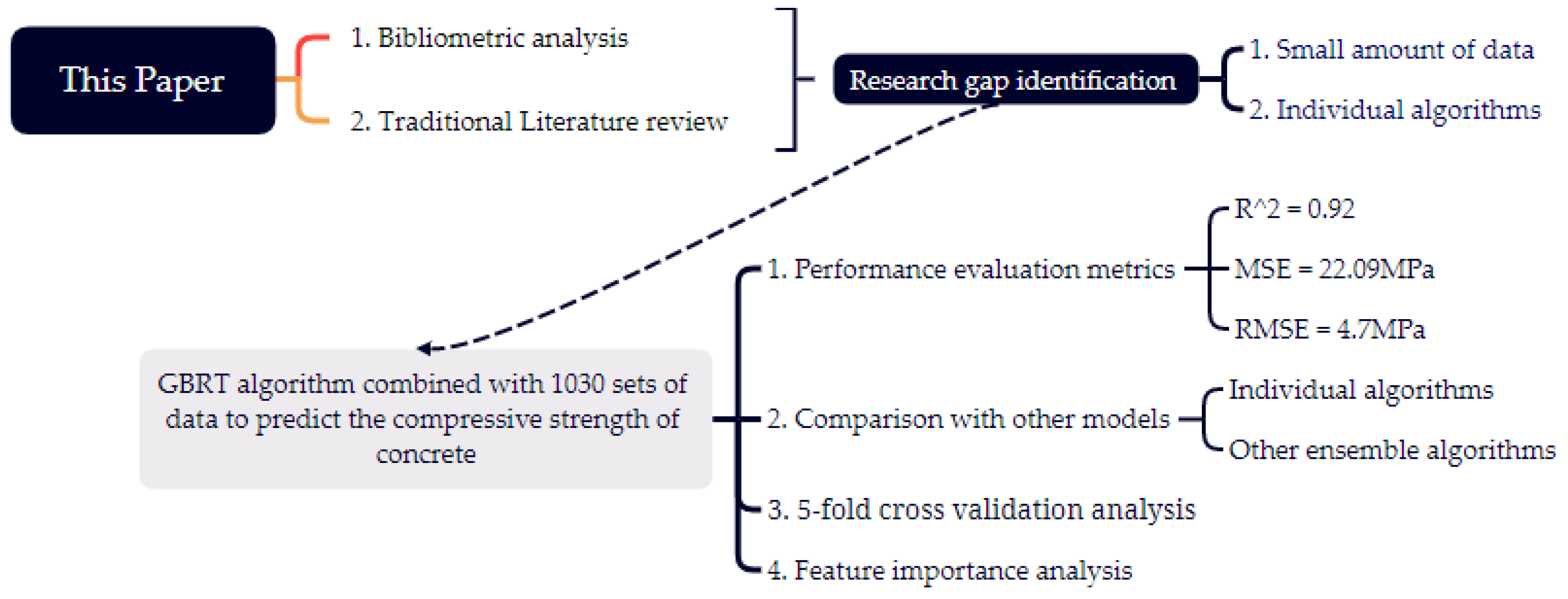

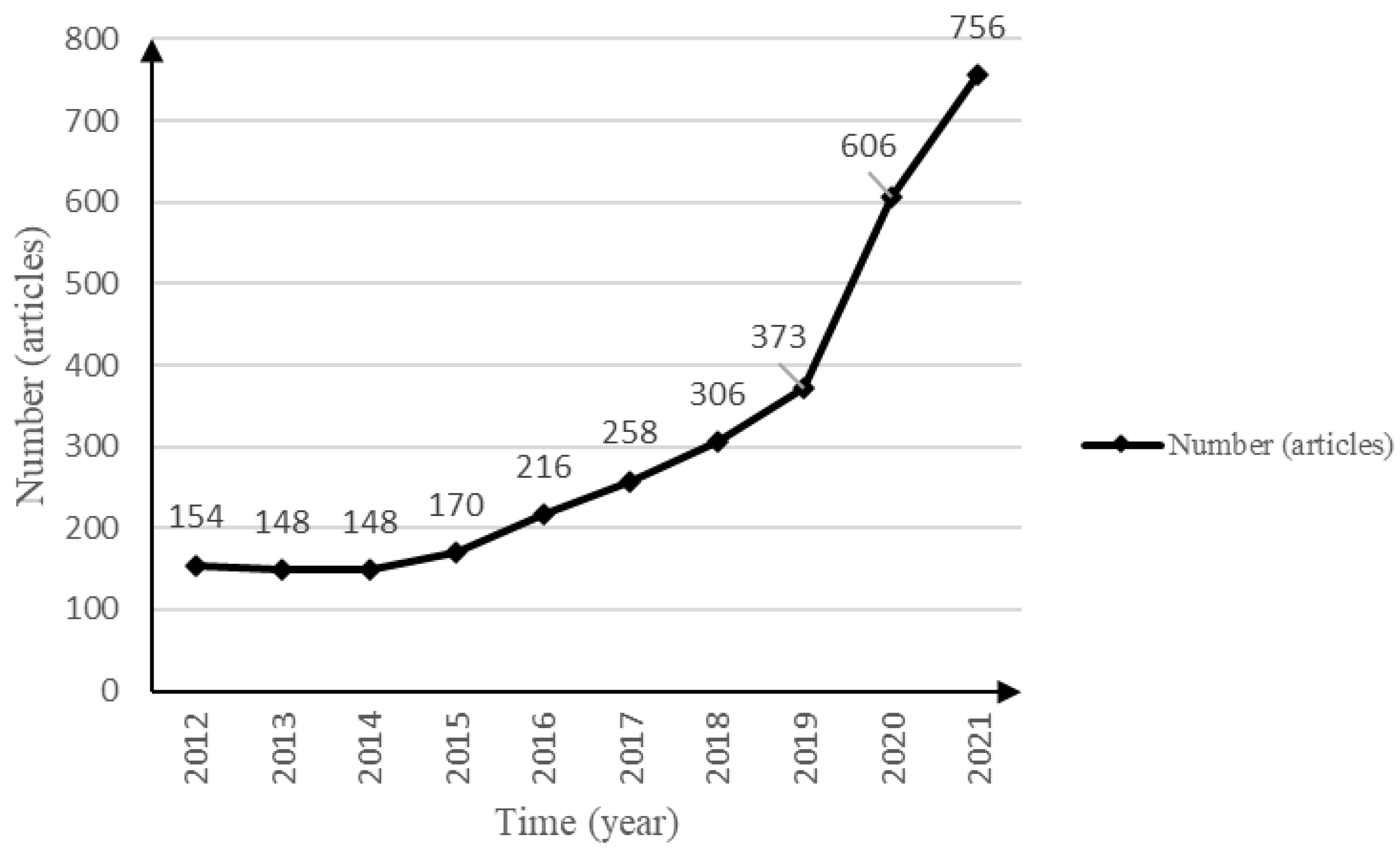
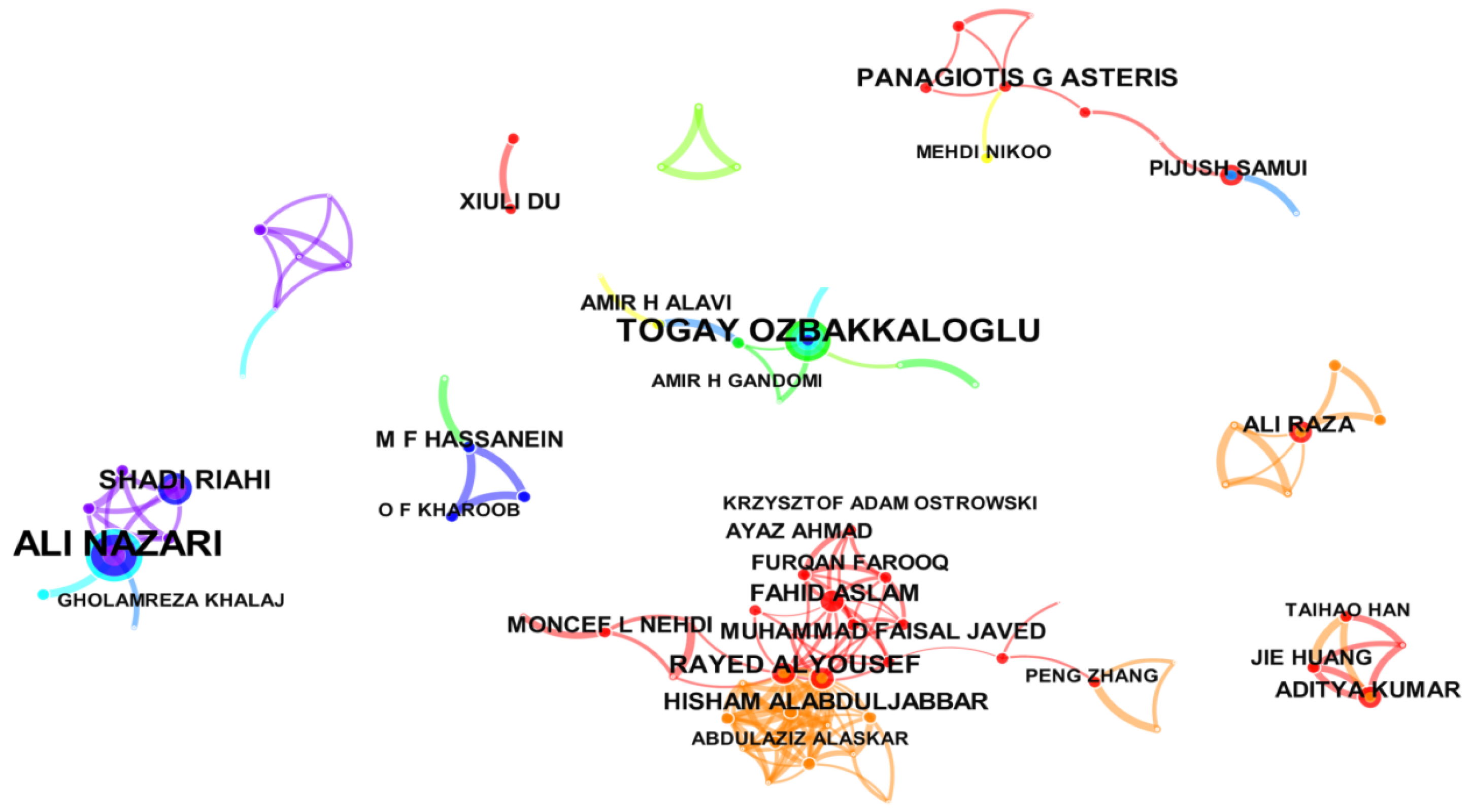
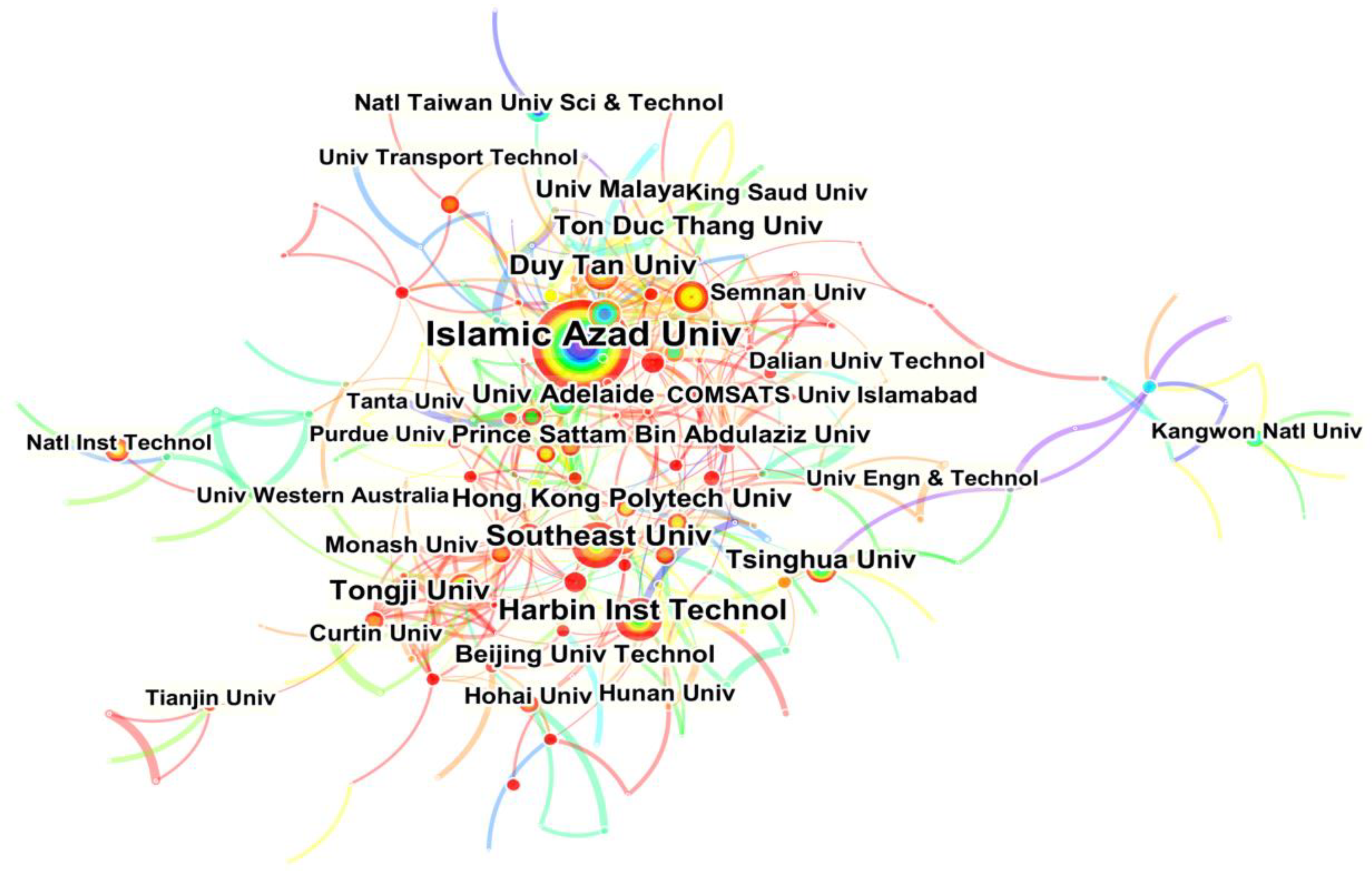
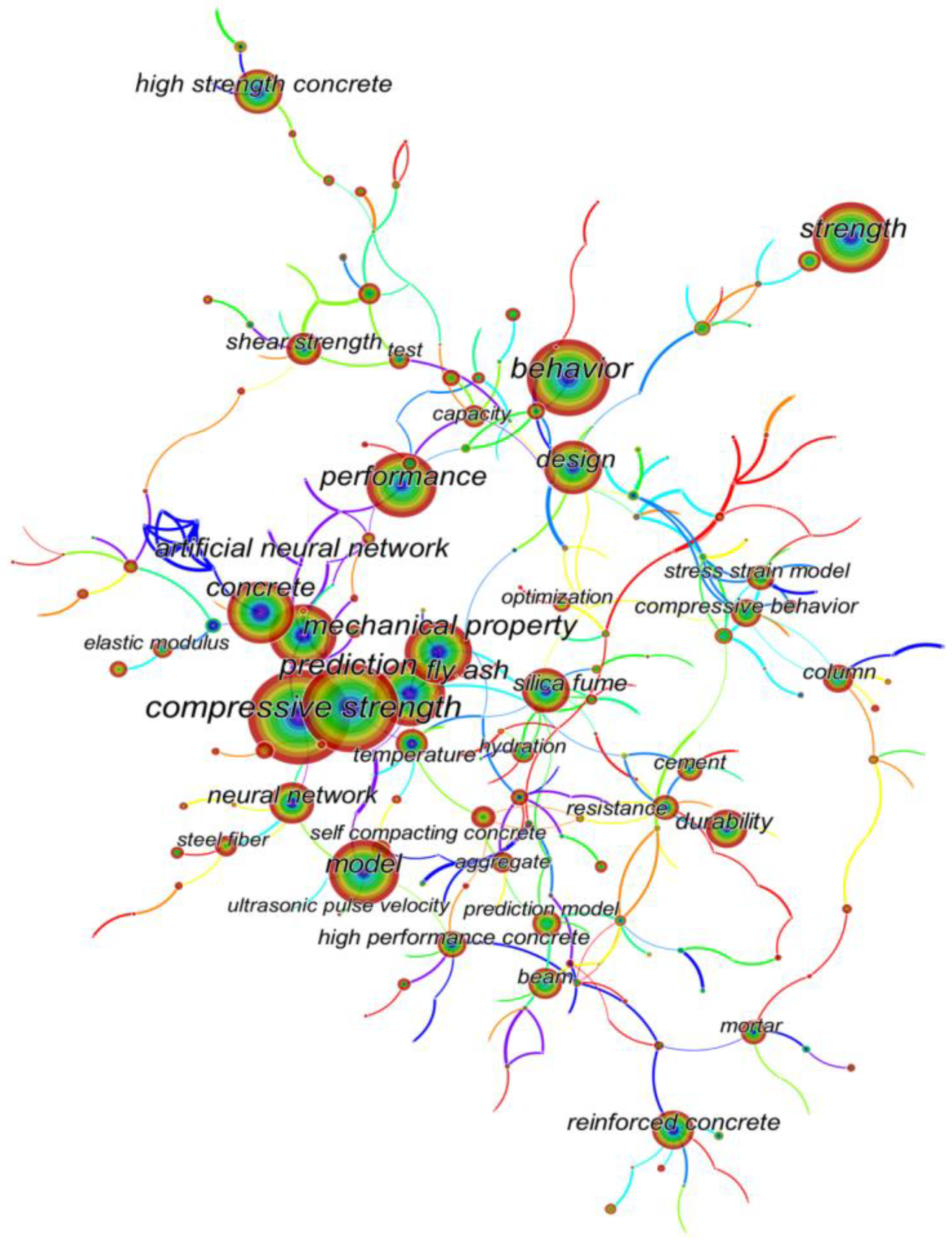
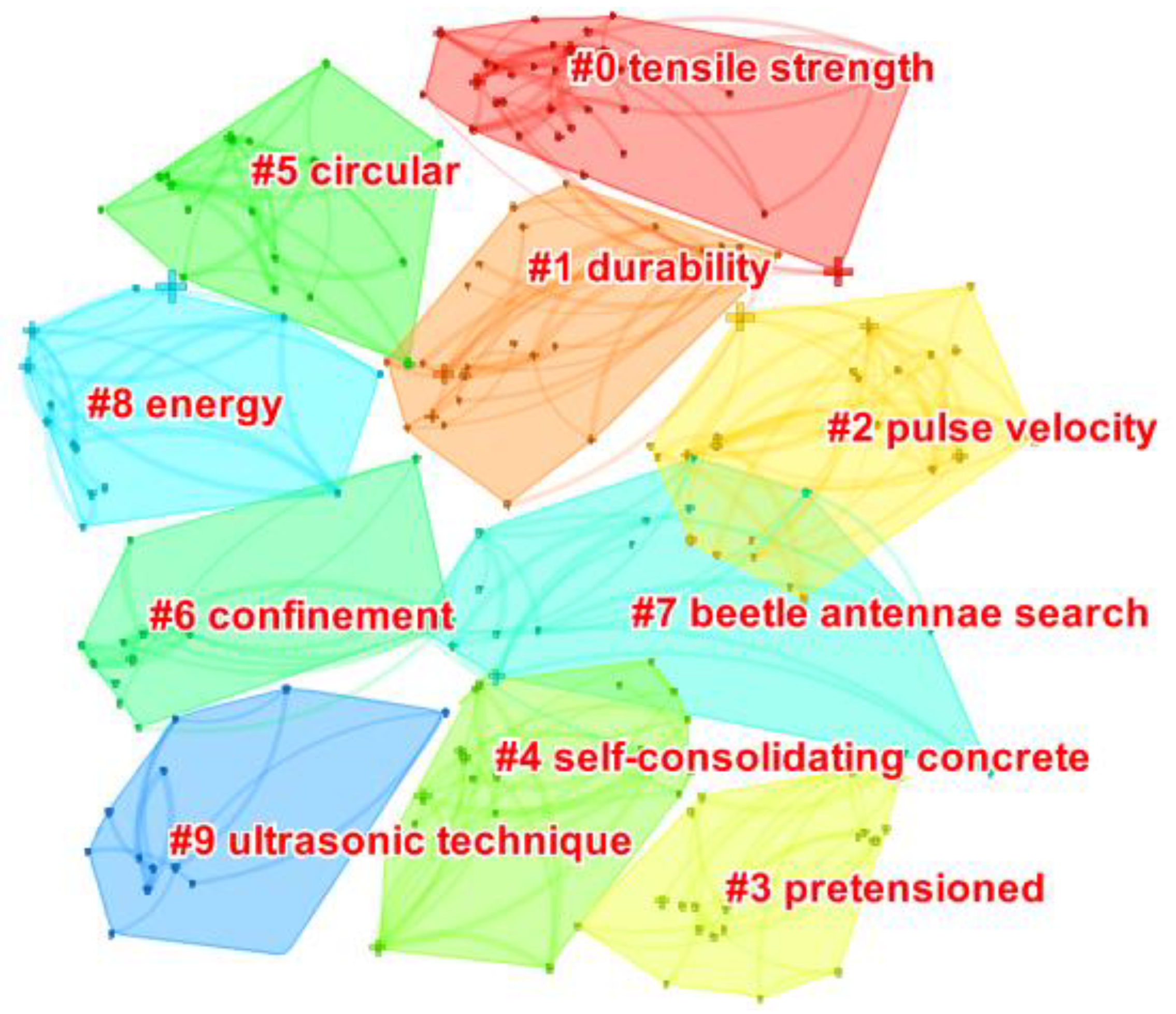
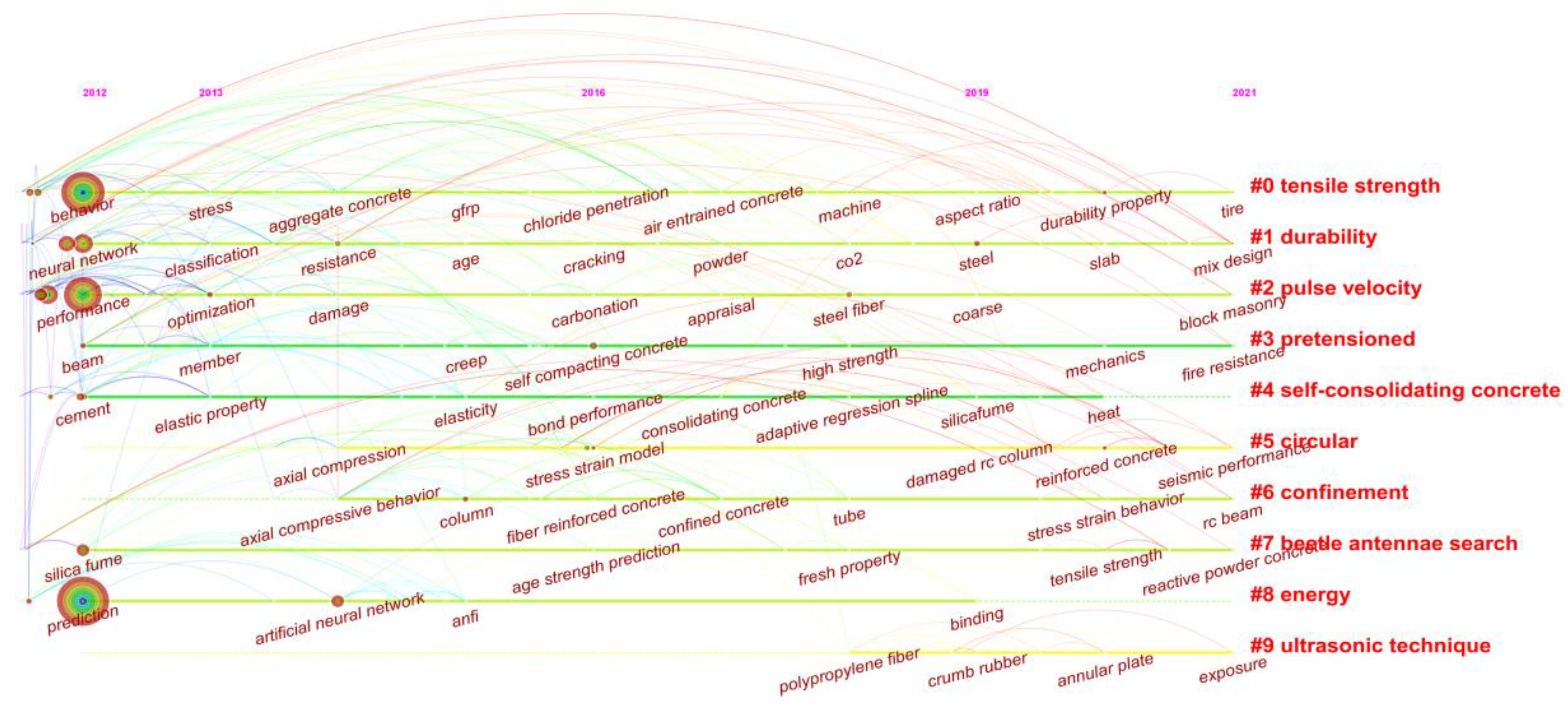

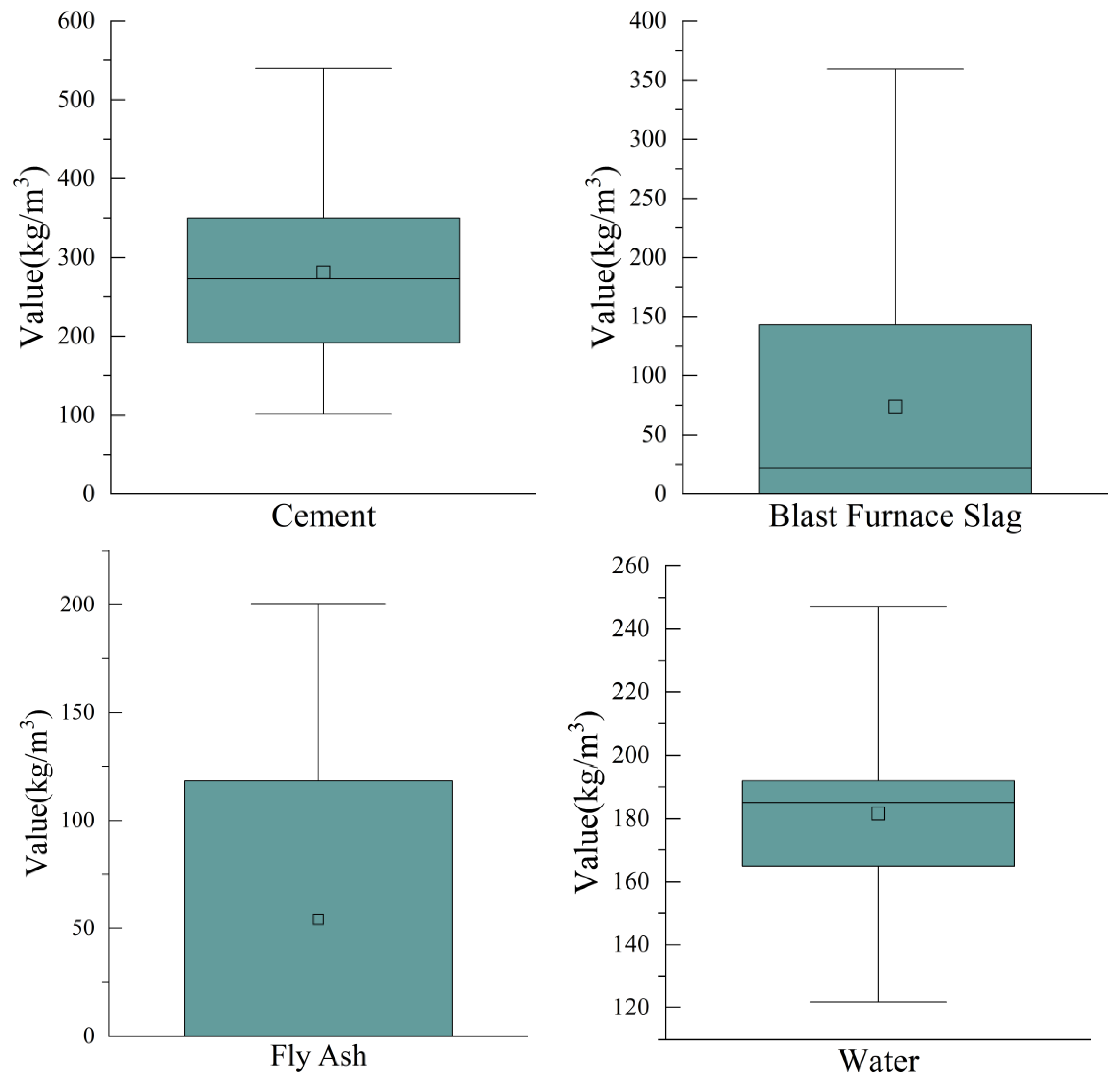

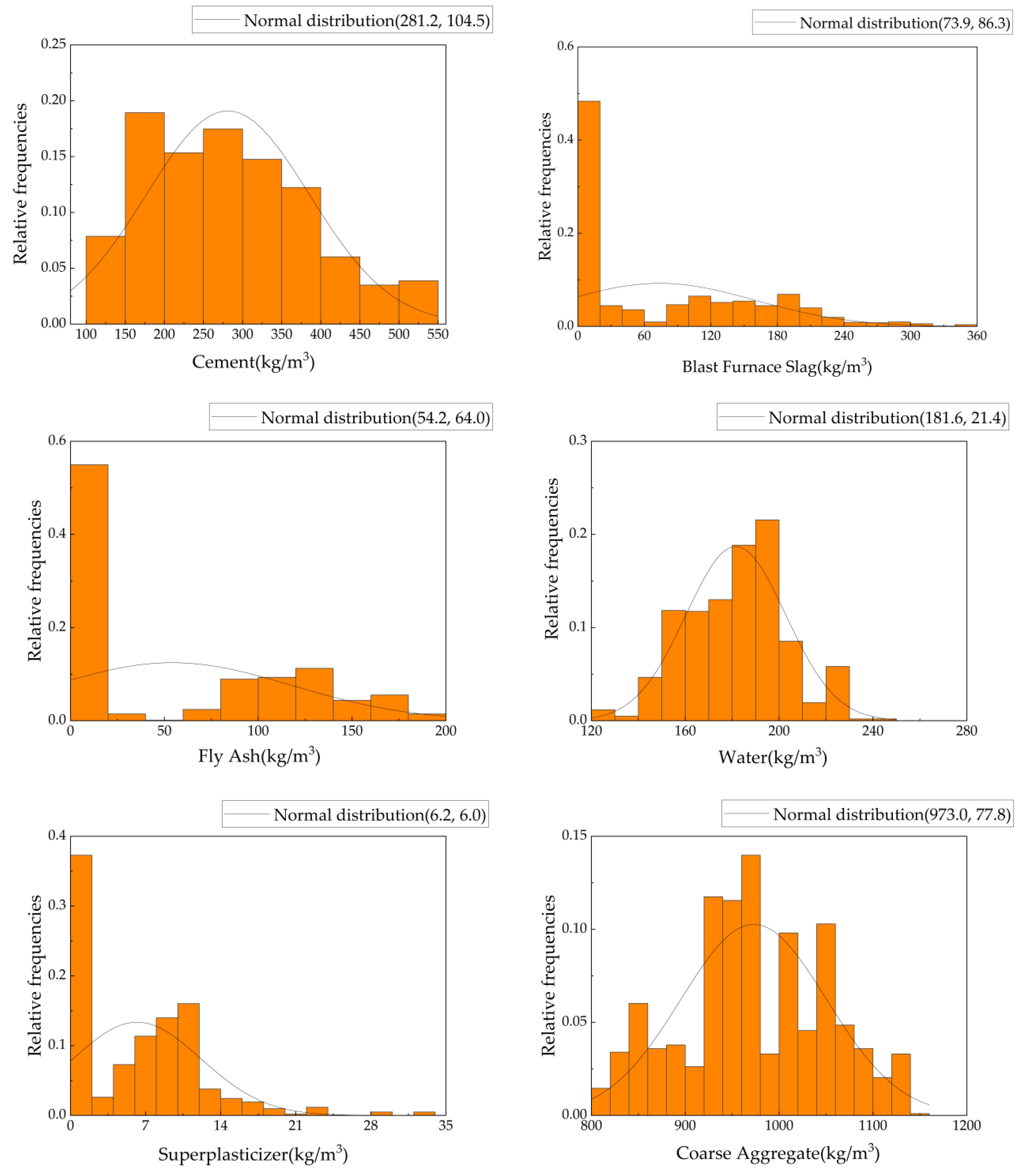
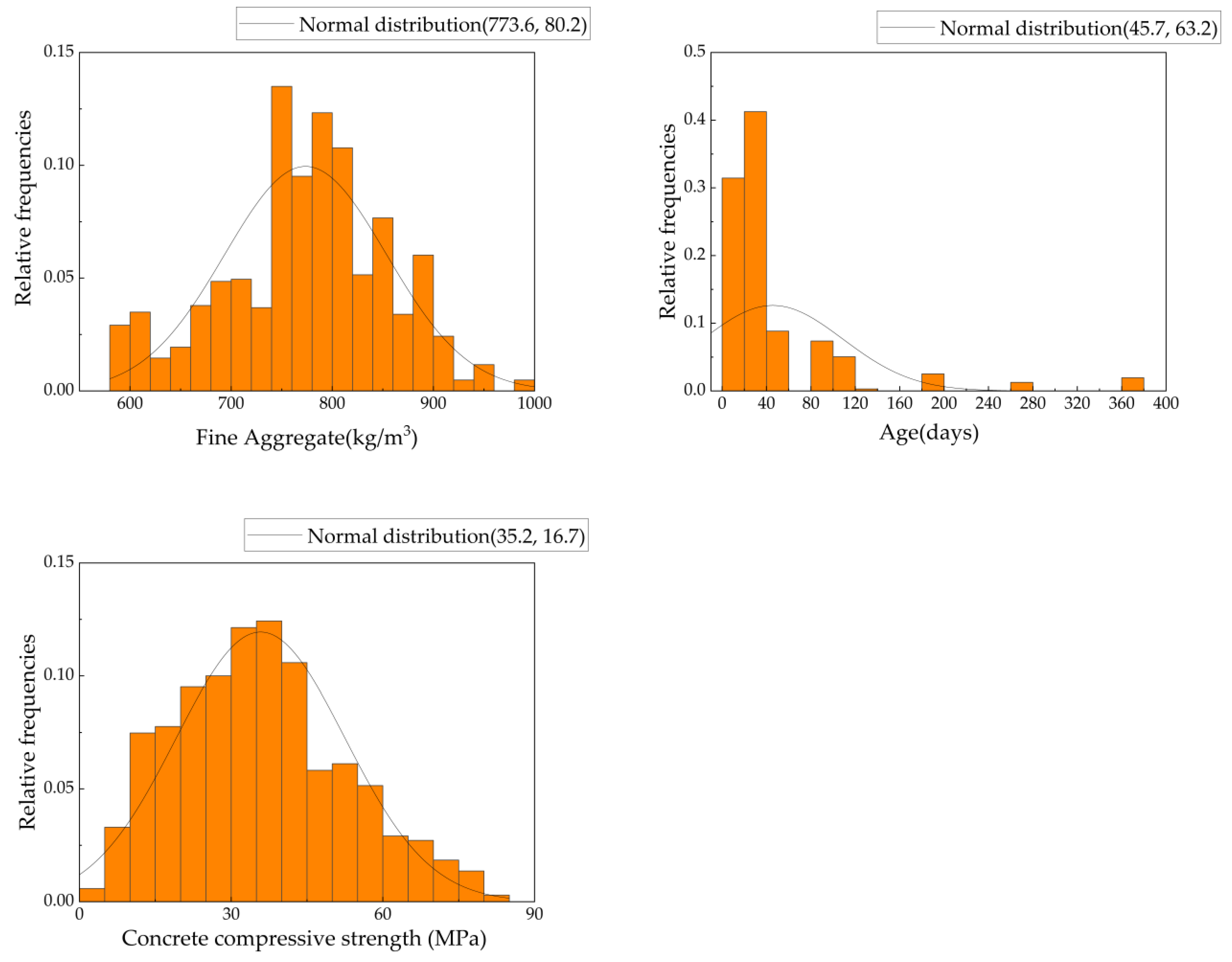

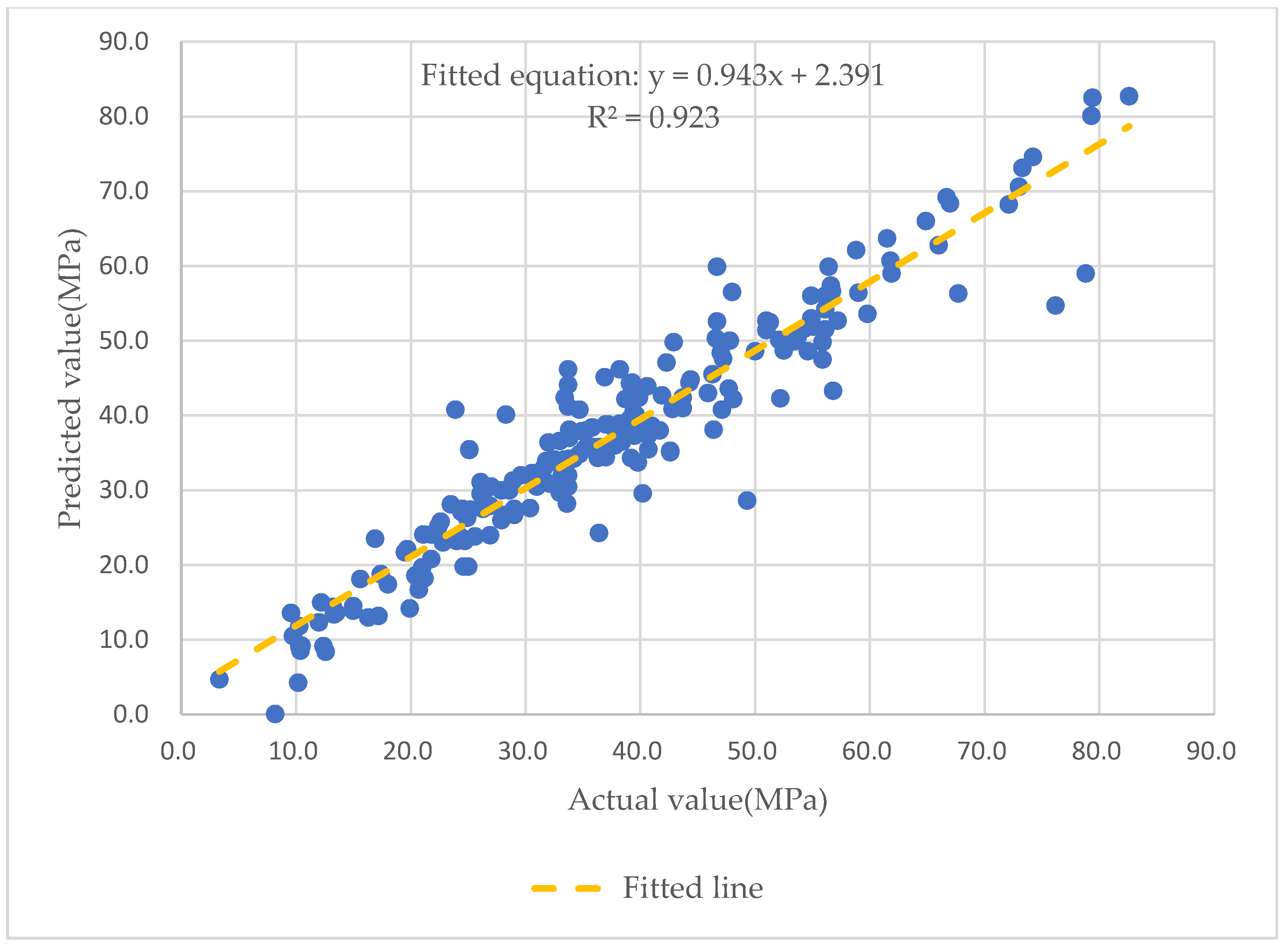



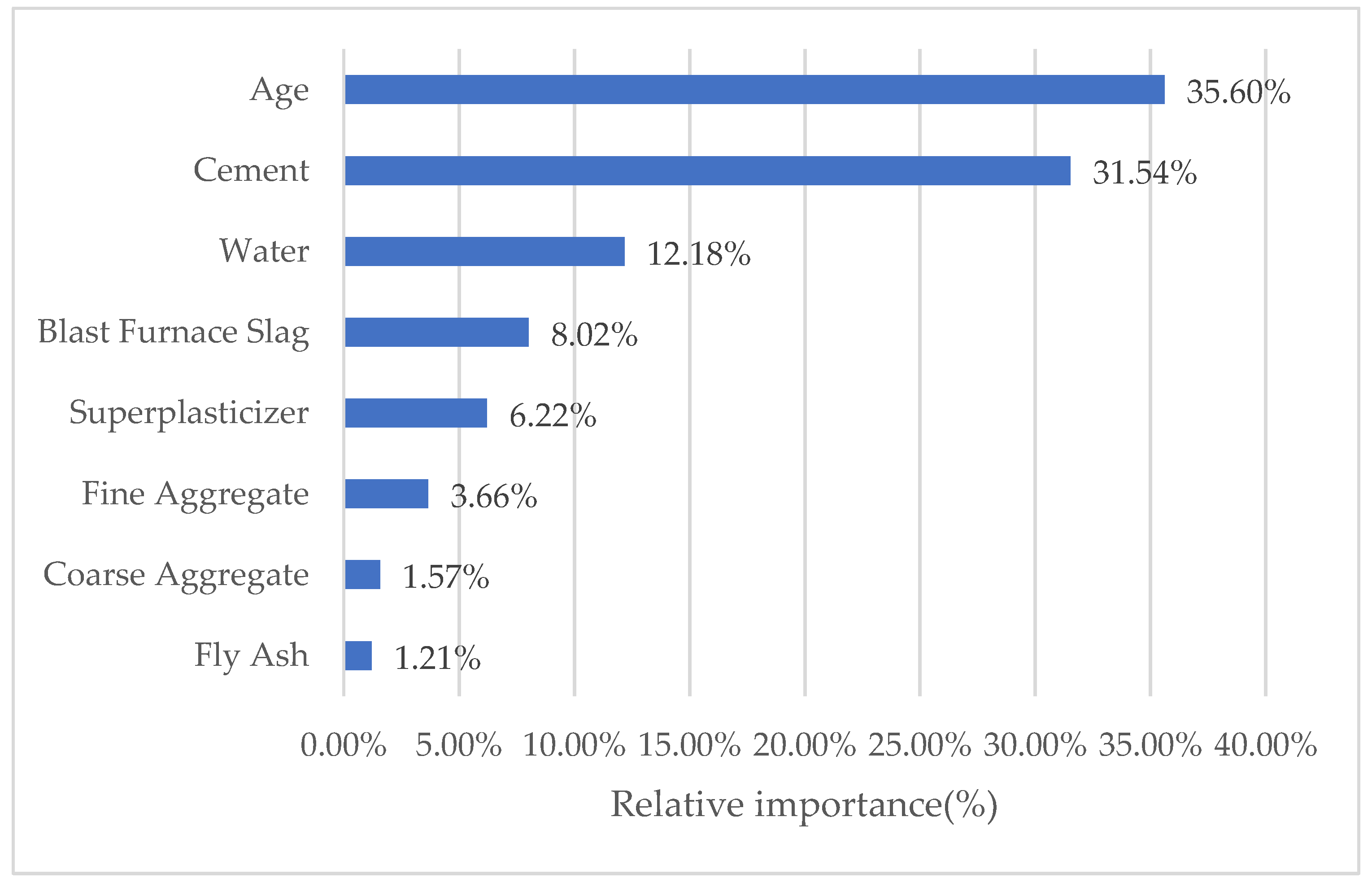
| Database | Web of Science Core Collection |
|---|---|
| Search method | Subject |
| Search vocabulary | Prediction of compressive strength of concrete |
| Time span | 2012–2021 |
| Search results | 3135 articles |
| Cluster ID | Size | Silhouette | Representative Label (LLR) | Year Ave. |
|---|---|---|---|---|
| 0 | 33 | 0.923 | Tensile strength | 2016 |
| 1 | 30 | 0.794 | Durability | 2016 |
| 2 | 24 | 0.96 | Pulse velocity | 2014 |
| 3 | 21 | 0.876 | Pretensioned | 2016 |
| 4 | 21 | 0.856 | Self-consolidating concrete | 2015 |
| 5 | 19 | 0.937 | Circular | 2018 |
| 6 | 16 | 0.875 | Confinement | 2016 |
| 7 | 15 | 0.966 | Beetle antennae search | 2016 |
| 8 | 14 | 0.903 | Energy | 2013 |
| 9 | 12 | 0.917 | Ultrasonic technique | 2019 |
| Author | Research Methods | Data Volume | Results |
|---|---|---|---|
| Liu et al. [46] | FCT prediction method | 100 | Relative error less than 10% |
| Soh and Bhalla [47] | EMI non-destructive testing | 15 | R2 = 0.955 |
| Zheng [48] | Equivalent age theory | 54 | Maximum error rate less than 10% |
| Elaty [49] | Summarising mathematical formulas | 6 | Not quantified |
| Nambiar and Ramamurthy [50] | Balshin’s generalised model | 11 | R2 = 0.893 |
| Author | Algorithm | Data Volume | Results |
|---|---|---|---|
| Lai and Serra [52] | ANN | 240 | Relative error less than 5% |
| Kewalramani and Gupta [53] | ANN | 864 | Maximum error rate 25.69% |
| Naderpour et al. [54] | ANN | 139 | R = 0.8926, MSE = 0.004447 |
| Asteris and Kolovos [55] | ANN | 205 | R2 = 0.919 |
| Zhu et al. [56] | GA-SVM | 24 | Maximum relative error 2.42% |
| Aiyer et al. [57] | SVM | 80 | R = 0.94 |
| Pham et al. [58] | SVM | 239 | R2 = 0.87, RMSE = 4.86, MAPE = 9.81% |
| Li and Peng [59] | BP, RBF | 19 | Relative error less than 6% |
| Gao and Hao [60] | BP-ANN | 30 | Absolute error less than 5.0% |
| Ma and Liu [61] | BP | 251 | Coefficient of variation = 0.112 |
| Wu et al. [63] | RF | 56 | R2 = 0.969, RMSE = 0.0149 |
| Cui et al. [64] | RF | 1030 | R2 = 0.902, MAE = 3.761, MAPE = 12.807, RMSE = 5.342 |
| Farooq et al. [65] | RF, GEP | 357 | R2 = 0.96(RF), R2 = 0.9(GEP) |
| Feng et al. [66] | AdaBoost | 1030 | R2 = 0.952, MAPE = 11.39%, RMSE =4.856 |
| Parameter | Range | Mean | Variance | Standard Deviation | Type |
|---|---|---|---|---|---|
| Cement (kg/m3) | 102.0–540.0 | 281.2 | 10911.1 | 104.5 | Input |
| Blast Furnace Slag (kg/m3) | 0.0–359.4 | 73.9 | 7436.9 | 86.2 | Input |
| Fly Ash (kg/m3) | 0.0–200.1 | 54.2 | 4091.6 | 64.0 | Input |
| Water (kg/m3) | 121.8–247.0 | 181.6 | 455.6 | 21.3 | Input |
| Superplasticizer (kg/m3) | 0.0–32.2 | 6.2 | 35.6 | 6.0 | Input |
| Coarse Aggregate (kg/m3) | 801.0–1145.0 | 972.9 | 6039.8 | 77.7 | Input |
| Fine Aggregate (kg/m3) | 594.0–992.6 | 773.6 | 6421.9 | 80.1 | Input |
| Age (days) | 1–365 | 45.7 | 3986.6 | 63.1 | Input |
| Concrete compressive strength (MPa) | 2.3–82.6 | 35.8 | 278.8 | 16.7 | Output |
| Data Set Type | Role | Data Volume |
|---|---|---|
| Training set | Training and generating models | 618 (60%) |
| Validation set | Adjusting hyperparameters & preventing overfitting | 206 (20%) |
| Test set | Evaluating model performance | 206 (20%) |
| Algorithm | Data Volume | Evaluation Indicators | Refs. | |
|---|---|---|---|---|
| R2 | RMSE(MPa) | |||
| GBRT | 1030 | 0.92 | 4.70 | This paper |
| ANN | 1030 | 0.90 | 5.14 | [66] |
| ANN | 1030 | 0.91 | 5.03 | [74] |
| ANN | 1030 | 0.91 | 5.57 | [75] |
| SVM | 1030 | 0.89 | 5.62 | [74] |
| SVM | 1030 | 0.86 | 6.28 | [66] |
| Algorithm | Data Volume | Evaluation Indicators | Refs. | |
|---|---|---|---|---|
| R2 | RMSE(MPa) | |||
| GBRT | 1030 | 0.92 | 4.70 | This paper |
| RF | 1030 | 0.90 | 5.34 | [64] |
| AdaBoost | 1030 | 0.95 | 4.86 | [66] |
| Number of Folds | Evaluation Indicators | |
|---|---|---|
| R2 | RMSE(MPa) | |
| Fold 1 | 0.901 | 4.689 |
| Fold 2 | 0.891 | 4.933 |
| Fold 3 | 0.916 | 4.567 |
| Fold 4 | 0.930 | 4.484 |
| Fold 5 | 0.890 | 5.700 |
| Average | 0.906 | 4.875 |
| Parameter | Importance Factor |
| Cement (kg/m3) | 0.3154 |
| Blast Furnace Slag (kg/m3) | 0.0802 |
| Fly Ash (kg/m3) | 0.0121 |
| Water (kg/m3) | 0.1218 |
| Superplasticizer (kg/m3) | 0.0622 |
| Coarse Aggregate (kg/m3) | 0.0157 |
| Fine Aggregate (kg/m3) | 0.0366 |
| Age (days) | 0.3560 |
Disclaimer/Publisher’s Note: The statements, opinions and data contained in all publications are solely those of the individual author(s) and contributor(s) and not of MDPI and/or the editor(s). MDPI and/or the editor(s) disclaim responsibility for any injury to people or property resulting from any ideas, methods, instructions or products referred to in the content. |
© 2023 by the authors. Licensee MDPI, Basel, Switzerland. This article is an open access article distributed under the terms and conditions of the Creative Commons Attribution (CC BY) license (https://creativecommons.org/licenses/by/4.0/).
Share and Cite
Li, D.; Tang, Z.; Kang, Q.; Zhang, X.; Li, Y. Machine Learning-Based Method for Predicting Compressive Strength of Concrete. Processes 2023, 11, 390. https://doi.org/10.3390/pr11020390
Li D, Tang Z, Kang Q, Zhang X, Li Y. Machine Learning-Based Method for Predicting Compressive Strength of Concrete. Processes. 2023; 11(2):390. https://doi.org/10.3390/pr11020390
Chicago/Turabian StyleLi, Daihong, Zhili Tang, Qian Kang, Xiaoyu Zhang, and Youhua Li. 2023. "Machine Learning-Based Method for Predicting Compressive Strength of Concrete" Processes 11, no. 2: 390. https://doi.org/10.3390/pr11020390
APA StyleLi, D., Tang, Z., Kang, Q., Zhang, X., & Li, Y. (2023). Machine Learning-Based Method for Predicting Compressive Strength of Concrete. Processes, 11(2), 390. https://doi.org/10.3390/pr11020390







